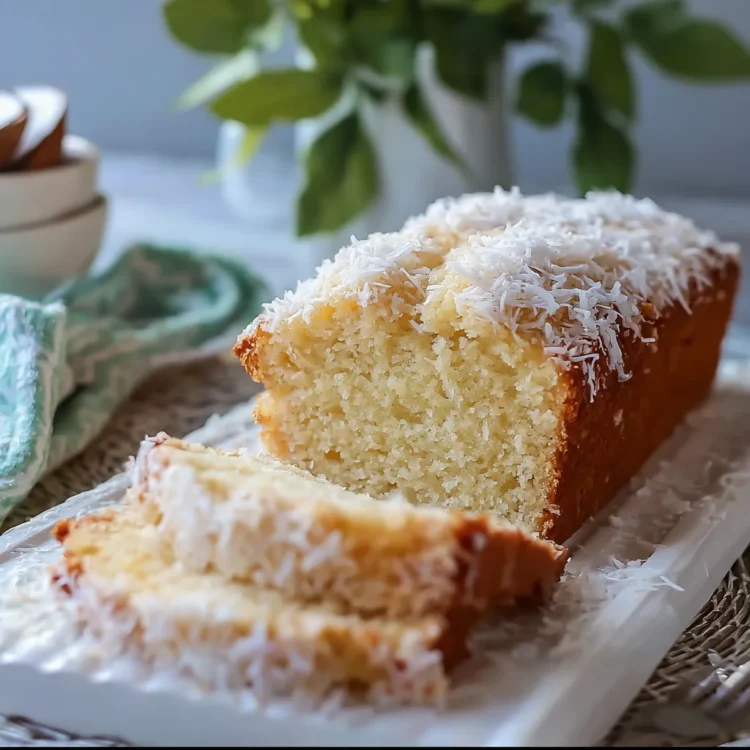When it comes to simple yet delicious baked goods, few desserts stand out as much as a coconut loaf cake. Its buttery texture, rich coconut flavor, and light sweetness make it a crowd-pleaser for any occasion, from casual afternoon teas to more formal brunches. If you’ve never made a coconut loaf cake, or you’re simply looking to improve your baking game, this guide will help you master the recipe and elevate your baking skills.
In this comprehensive guide, we’ll walk you through the essential tips, ingredient breakdowns, and the step-by-step process of baking the perfect coconut loaf cake. Whether you’re a novice or an experienced baker, our recipe will ensure a delicious result every time!
Why You’ll Love Coconut Loaf Cake
Coconut loaf cake has become a beloved favorite among cake lovers for a reason. Here’s why it should be your go-to dessert:
-
Versatile for Any Occasion: From holidays to weekend get-togethers, it’s an ideal choice for any time you crave a light yet flavorful dessert.
-
Tropical Flavor Profile: The subtle coconut essence transports your taste buds straight to a tropical paradise.
-
Moist and Buttery Texture: When made correctly, a coconut loaf cake is incredibly moist and light, perfect for pairing with a hot cup of coffee or tea.
-
Easy to Make: With just a few simple ingredients and minimal effort, you can whip up this cake in no time.
But let’s dive deeper into how you can perfect this simple recipe, adding layers of flavor and texture to make your coconut loaf cake truly special.
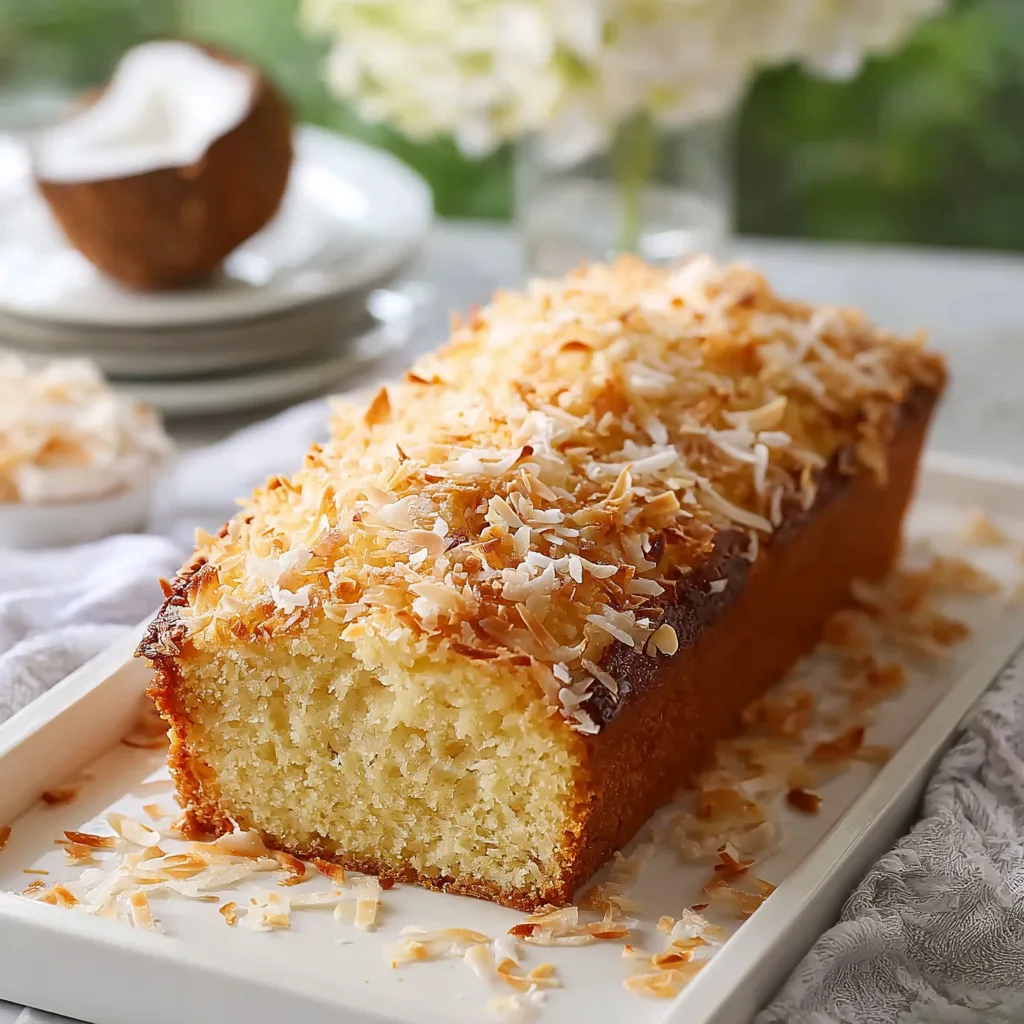
Ingredients for the Perfect Coconut Loaf Cake
To make a coconut loaf cake, it’s essential to use high-quality ingredients. Each ingredient plays a role in contributing to the cake’s taste and texture. Below is a breakdown of the ingredients you’ll need and why they matter:
-
Unsalted Butter: The primary fat in this cake, unsalted butter helps to achieve a rich, moist texture. Always use high-quality butter for the best flavor.
-
Granulated Sugar: Provides the sweetness, balancing the coconut’s natural flavor. You can also experiment with coconut sugar for a deeper, caramel-like sweetness.
-
Eggs: Eggs are crucial for binding the ingredients together, ensuring the loaf is fluffy and moist. If possible, opt for organic eggs to enhance the cake’s richness.
-
All-Purpose Flour: The structure of the cake depends on the flour. Use high-quality all-purpose flour to achieve a light yet firm texture.
-
Baking Powder: This leavening agent ensures the loaf rises properly without being too dense.
-
Salt: A pinch of salt enhances all the other flavors and balances the sweetness of the cake.
-
Unsweetened Coconut Milk (Canned): This is thicker than the carton variety, making it perfect for a moist and rich batter. Always go for canned coconut milk for this recipe.
-
Shredded Coconut: This is the star of the cake, lending both flavor and texture. You can use sweetened or unsweetened coconut, depending on your taste.
In addition to the above, we’ll also be making a simple coconut glaze to finish off the loaf. It adds a layer of sweetness and a beautiful glossy finish.
A Perfect Coconut Loaf Cake Recipe
Here’s a step-by-step guide to baking your own coconut loaf cake. Follow these instructions carefully for a perfect result every time.
Ingredients
For the Coconut Loaf Cake:
-
1 cup unsalted butter (room temperature)
-
1 1/2 cups granulated sugar
-
3 large eggs (room temperature)
-
1/2 tsp vanilla extract (pure)
-
1/2 tsp almond extract (optional for a nutty flavor)
-
1 1/2 cups all-purpose flour (sifted)
-
1/2 tsp baking powder
-
1 tsp salt
-
1/2 cup unsweetened coconut milk (canned)
-
1 cup shredded coconut (unsweetened or sweetened)
For the Coconut Glaze:
-
1 cup powdered sugar
-
1/3 cup unsweetened coconut milk (canned)
-
1 tsp vanilla extract
Instructions
-
Preheat Your Oven: Preheat your oven to 350°F (175°C). Prepare a loaf pan (9×5 inches) by greasing it with butter or lining it with parchment paper.
-
Prepare the Wet Ingredients: In a large mixing bowl, beat the softened butter and sugar together using a hand mixer or stand mixer. Continue mixing until the mixture is light and fluffy (about 3 minutes). Add eggs one at a time, beating well after each addition. Stir in the vanilla and almond extracts until fully incorporated.
-
Add Dry Ingredients: In a separate bowl, whisk together the sifted flour, baking powder, and salt. Slowly add the dry ingredients to the wet mixture, alternating with coconut milk, mixing until just combined. Scrape down the sides of the bowl to ensure everything is well incorporated.
-
Incorporate Shredded Coconut: Gently fold in the shredded coconut with a spatula. This step is key to ensuring the coconut is evenly distributed throughout the batter.
-
Bake the Loaf: Pour the batter into your prepared loaf pan, smoothing the top with a spatula. Bake for 1 hour to 1 hour and 15 minutes. Start checking at the 50-minute mark. The cake is done when the top is golden brown and a toothpick inserted into the center comes out mostly clean.
-
Cool the Cake: Let the cake cool in the pan for about 10–15 minutes before transferring it to a wire rack to cool completely.
-
Prepare the Coconut Glaze: While the cake is cooling, prepare the coconut glaze. In a small bowl, whisk together the powdered sugar, coconut milk, and vanilla extract until smooth.
-
Glaze the Cake: Once the cake has cooled, drizzle the glaze over the top, allowing it to drip down the sides. Sprinkle with additional shredded coconut for a beautiful finishing touch.
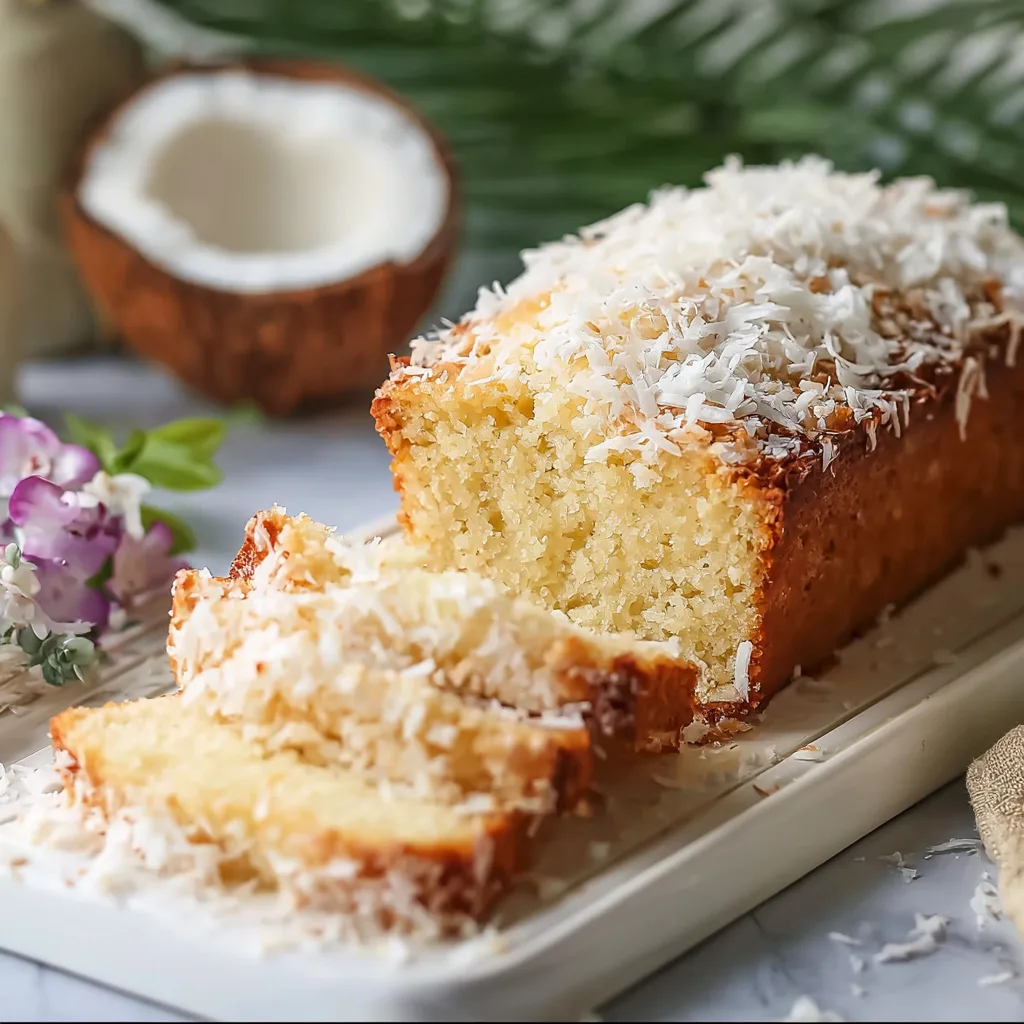
Helpful Tips for a Perfect Coconut Loaf Cake
-
Room Temperature Ingredients: Always use ingredients at room temperature, especially butter and eggs. They mix more easily and result in a smoother batter.
-
Quality of Ingredients: Don’t skimp on butter, eggs, and coconut milk. The flavor of these ingredients significantly impacts the final product.
-
Baking Time: Oven temperatures can vary, so it’s important to check your loaf with a toothpick. If the center is still wet, continue baking for 5-10 minutes, checking regularly.
-
Parchment Paper: Line your loaf pan with parchment paper. This makes it much easier to remove the cake from the pan without damaging its shape.
Once you’ve mastered the basics of coconut loaf cake, you can experiment by adding your personal twist. You could mix in some lime zest for a citrusy kick, or add dark chocolate chips for a touch of richness. The possibilities are endless!
How to Make Coconut Loaf Cake: Step-by-Step Guide
When making a coconut loaf cake, attention to detail is key. Every step contributes to creating that perfect texture, flavor, and presentation. Below is a more in-depth breakdown of the process, as well as some insider tips to ensure your cake turns out perfectly moist and flavorful every time.
Step 1: Prepare Your Ingredients and Tools
Before you dive into mixing the ingredients, take a few moments to get everything ready. Here’s what you’ll need:
-
Measuring Cups and Spoons: Accurate measurements are vital to getting the right texture and balance of flavors.
-
Mixer: Whether you use a hand mixer or a stand mixer, make sure it’s ready for action.
-
Loaf Pan: A standard 9×5-inch loaf pan works well for this recipe. If you’re using a different size, be aware that baking times might need to be adjusted.
-
Parchment Paper: This is key for easy removal of the loaf from the pan once it’s baked.
Also, ensure that your butter and eggs are at room temperature. This will allow them to incorporate more easily into the batter, resulting in a smoother texture.
Step 2: Mix the Wet Ingredients
The first step in the mixing process is to cream together the butter and sugar. This process aerates the butter, helping the loaf rise and giving it that light, fluffy texture.
-
Cream the Butter and Sugar: In a large bowl, use your mixer to beat the butter and sugar until it becomes light and fluffy (about 3 minutes). This step is crucial for creating a soft crumb in the final cake.
-
Add the Eggs: Incorporate the eggs one at a time. Make sure to mix thoroughly after each egg to ensure even distribution. The eggs act as a binding agent and add moisture to the batter.
-
Add the Extracts: Mix in the vanilla and almond extracts. Pure extracts are best as they provide the richest flavor. The almond extract will add a subtle nutty flavor, but if you prefer a more coconut-forward taste, feel free to skip it.
Step 3: Combine the Dry Ingredients
In a separate bowl, sift together the flour, baking powder, and salt. Sifting is important because it helps to distribute the dry ingredients evenly, preventing clumps and ensuring that the cake rises uniformly.
-
Add Dry Ingredients to Wet Ingredients: Gradually add the dry ingredients to the wet mixture, alternating with coconut milk. This will help prevent the flour from forming lumps and ensure a smooth batter. Mix until just combined—don’t overwork the batter, as this can result in a dense loaf.
-
Incorporate Shredded Coconut: Gently fold in the shredded coconut by hand, using a spatula. This ensures that the coconut is evenly distributed without overmixing the batter.
Step 4: Bake the Coconut Loaf Cake
Now it’s time to bake the cake. Transfer the batter into your prepared loaf pan and smooth the top with a spatula to ensure it’s even.
-
Bake at 350°F (175°C): Place the loaf pan in the center of the preheated oven. Set your timer for 1 hour and 15 minutes, but start checking around 50 minutes. Baking times can vary based on your oven and the material of your loaf pan. Ceramic pans tend to cook faster, while metal pans might need a bit more time.
-
Check for Doneness: The easiest way to test if your cake is done is by inserting a toothpick into the center. If it comes out clean or with just a few moist crumbs, the cake is ready. The top should be golden brown, and the cake should spring back when gently pressed.
-
Cool Before Removing from the Pan: Let the cake cool in the pan for 10 to 15 minutes before transferring it to a wire rack. This cooling time helps the cake firm up and reduces the risk of it falling apart.
Step 5: Make the Coconut Glaze
While the cake is cooling, prepare the coconut glaze to give your cake a glossy, sweet finish. This glaze enhances the flavor and adds a smooth texture.
-
Whisk Together the Ingredients: In a small bowl, combine powdered sugar, coconut milk, and vanilla extract. Whisk until smooth. You want the glaze to be thick enough to drip but not run off too quickly.
-
Drizzle the Glaze: Once the cake has cooled for 10-15 minutes, drizzle the glaze generously over the top. The glaze will slowly drip down the sides, adding a beautiful sheen and an extra layer of sweetness. If you prefer a thicker glaze, you can refrigerate it for 10 minutes before drizzling.
Step 6: Garnish and Serve
To make your coconut loaf cake even more irresistible, sprinkle some shredded coconut over the top of the glaze. This adds texture and a little extra coconut flavor. You can also add lime zest, toasted coconut flakes, or even some chopped macadamia nuts for an added tropical twist.
Step 7: Slice and Enjoy
Once your cake is fully glazed and garnished, it’s time to slice and serve! The coconut loaf cake pairs perfectly with a cup of coffee, tea, or even a tropical fruit salad. The cake is moist, sweet, and full of coconut flavor, with a touch of crispness from the glaze.
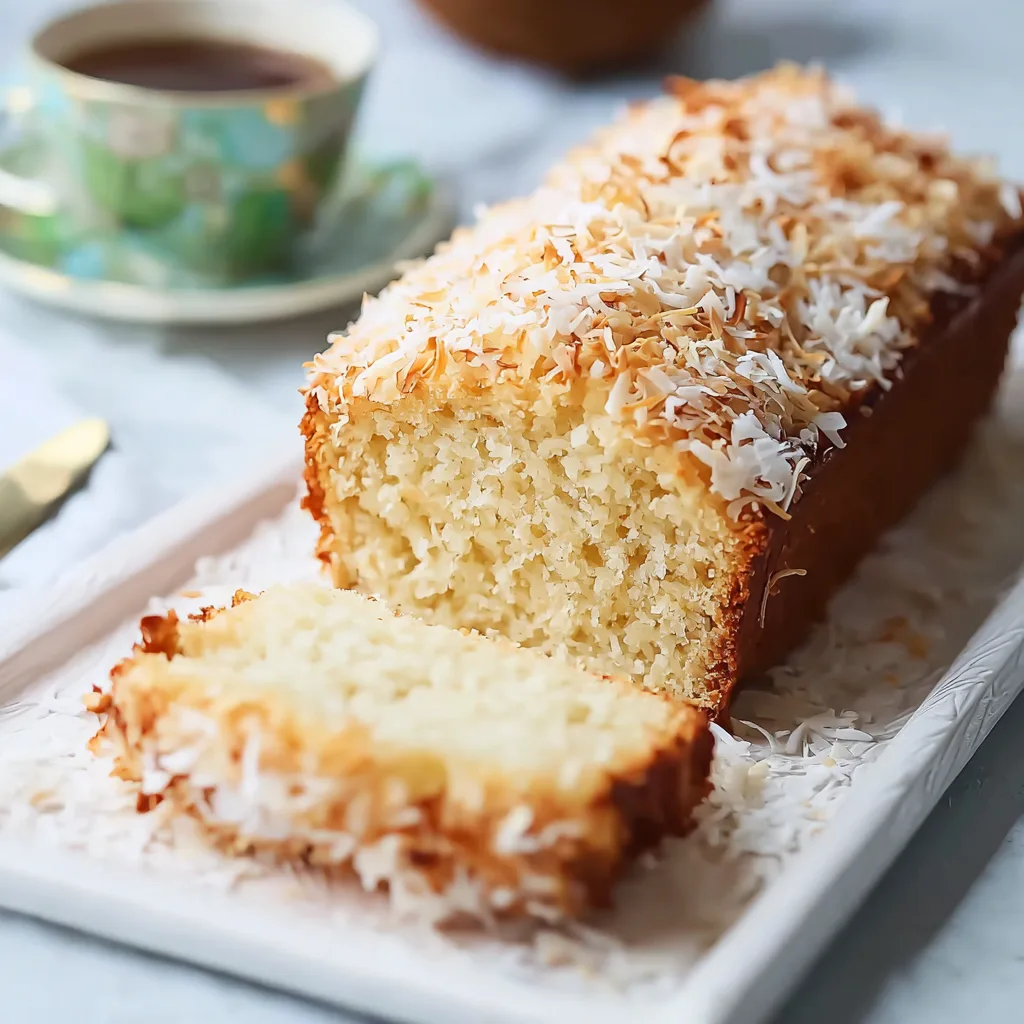
Tips for Customizing Your Coconut Loaf Cake
While the basic coconut loaf cake is delicious as is, there are many ways to make it your own. Below are a few ideas for adding variety to the recipe:
-
Add Citrus Zest: For a fresh, tangy twist, add lime or orange zest to the batter. The citrus notes pair wonderfully with coconut.
-
Chocolate Chip Coconut Loaf Cake: Add a handful of dark chocolate chips to the batter for a rich contrast against the coconut’s sweetness.
-
Coconut Flour Variation: If you’re gluten-free, you can substitute regular flour with coconut flour. However, you’ll need to adjust the liquid content since coconut flour absorbs moisture differently than all-purpose flour.
Troubleshooting Common Issues with Coconut Loaf Cake
Even experienced bakers encounter issues from time to time, so don’t be discouraged if your cake doesn’t turn out perfectly on the first try. Here are some common problems you might face and how to fix them:
1. Cake is Too Dry
Dryness is often the result of overbaking or using too much flour. Here’s how to avoid it:
-
Check the Cake Early: Start checking the cake for doneness around the 50-minute mark. Oven temperatures vary, and overbaking is the most common cause of dryness.
-
Measure Flour Carefully: Always measure flour correctly by spooning it into the cup and leveling it off. If you pack the flour too tightly, it can lead to excess flour in the batter.
2. Cake is Too Dense
A dense cake could mean you overmixed the batter or didn’t properly incorporate the ingredients. Here’s how to address this:
-
Don’t Overmix: Once you add the dry ingredients to the wet ingredients, mix just until combined. Overmixing activates the gluten, which can make the cake dense.
-
Room Temperature Ingredients: Using butter, eggs, and coconut milk at room temperature ensures that everything blends smoothly, resulting in a lighter texture.
3. Cake Sinks in the Middle
If the cake sinks in the middle after baking, it could be a sign that it wasn’t fully cooked or the oven temperature was too low. To prevent this:
-
Bake Long Enough: Ensure the center is fully cooked before removing the cake from the oven. A toothpick should come out clean, not wet.
-
Don’t Open the Oven Too Often: Every time you open the oven door, the temperature inside drops, which can affect the cake’s rise. Only open the oven when you need to check for doneness.
4. Glaze Too Runny or Too Thick
If your coconut glaze is too thin or too thick, it can affect the cake’s finish. Here’s what to do:
-
Adjust Consistency: If the glaze is too runny, add more powdered sugar. If it’s too thick, add a bit more coconut milk until you reach the desired consistency.
-
Use Immediately: Coconut glaze tends to thicken as it sits. To avoid this, make it just before glazing your cake to ensure it’s pourable.
Variations on Coconut Loaf Cake to Try
Once you’ve perfected the base coconut loaf cake, it’s easy to customize it for different flavors or dietary preferences. Here are some variations to try:
1. Coconut Lime Loaf Cake
Add the zest of one lime and a few tablespoons of lime juice to the batter. The tartness of the lime will balance the sweetness of the coconut, creating a fresh and vibrant twist on the classic.
2. Vegan Coconut Loaf Cake
To make this loaf cake vegan-friendly, replace the eggs with flax eggs (1 tablespoon flaxseed meal mixed with 3 tablespoons water per egg), and use coconut oil or vegan butter in place of regular butter. Ensure you use coconut milk that is free of additives and preservatives for a richer flavor.
3. Chocolate Coconut Loaf Cake
Mix in a handful of chocolate chips or chunks to the batter before baking. You can use dark chocolate for a more intense contrast with the sweetness of the coconut. The combination of coconut and chocolate is always a winner!
4. Gluten-Free Coconut Loaf Cake
For a gluten-free version, substitute all-purpose flour with a gluten-free flour blend. Be sure to check that the coconut milk you use is also gluten-free. You may need to adjust the liquid quantities slightly to account for the texture of gluten-free flour.
How to Serve and Store Coconut Loaf Cake
Once your coconut loaf cake is baked, glazed, and garnished, it’s time to enjoy! Here are some ideas on how to serve and store the cake for optimal freshness:
Serving Ideas
-
With a Hot Beverage: A slice of coconut loaf cake pairs wonderfully with a hot cup of tea, coffee, or even a tropical iced beverage. Consider serving it alongside a creamy latte or a refreshing fruit smoothie.
-
Topped with Fresh Fruit: For an added burst of flavor, serve the loaf with fresh tropical fruits such as mango, pineapple, or kiwi. The fruit adds a refreshing contrast to the sweet cake.
-
With a Scoop of Ice Cream: If you’re looking for a more indulgent treat, serve a slice of coconut loaf cake with a scoop of vanilla or coconut ice cream. The creamy ice cream complements the moist loaf cake perfectly.
Storage Tips
-
Room Temperature: Store the loaf cake in an airtight container at room temperature for up to 3 days. This will help preserve its moist texture.
-
Refrigerate for Longer Storage: If you want to keep the cake for a longer period, you can refrigerate it for up to a week. Be sure to wrap it tightly to prevent it from drying out.
-
Freezing Coconut Loaf Cake: You can freeze the loaf cake for up to 3 months. Simply wrap it tightly in plastic wrap and foil. To thaw, leave it at room temperature for several hours or overnight in the fridge before glazing and serving.
FAQs on Coconut Loaf Cake
1. Why is my coconut loaf cake dry?
Dry cakes can be the result of overbaking, too much flour, or using cold ingredients. To prevent dryness, make sure to check the cake regularly and avoid over-mixing the batter.
2. How should I store my coconut loaf cake?
Store the loaf in an airtight container at room temperature for up to 3 days. If you want it to last longer, freeze it for up to 2 months. Be sure to let it cool completely before storing.
3. Can I use sweetened coconut for this recipe?
Yes, you can use sweetened shredded coconut if you prefer a sweeter flavor. Just adjust the sugar in the recipe to balance the extra sweetness.
4. Can I make this recipe dairy-free?
Yes! Simply replace the butter with a dairy-free substitute, such as coconut oil or a plant-based margarine, and use coconut milk as the only liquid.
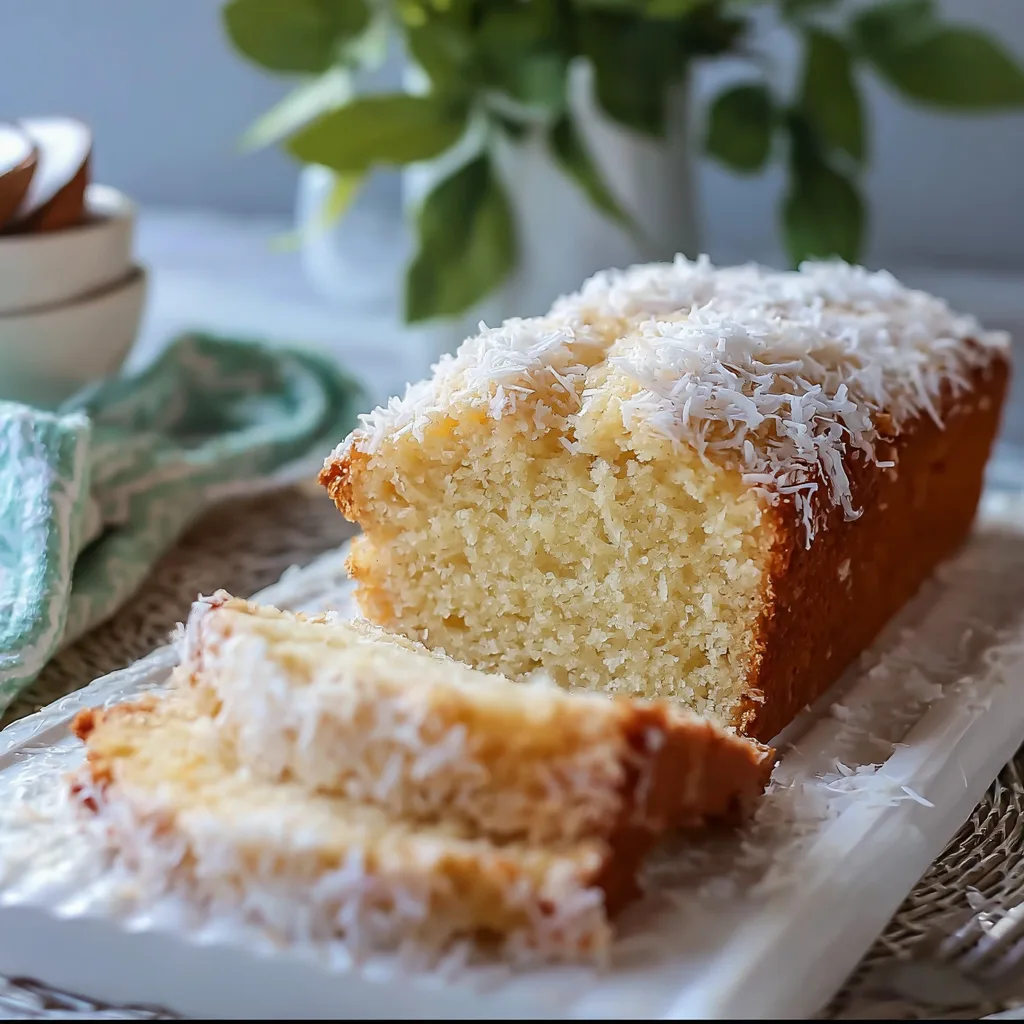
Conclusion: Your Ultimate Coconut Loaf Cake Recipe
Now that you have all the tools, tips, and variations for making the perfect coconut loaf cake, it’s time to get baking! Whether you’re hosting a special event, enjoying a cozy afternoon at home, or just craving something sweet, this recipe is sure to deliver a delicious, moist cake every time.
The beauty of this coconut loaf cake lies in its simplicity, versatility, and the wonderful tropical flavors that make it a standout treat. Experiment with different variations, and don’t forget to share your coconut loaf cake with family and friends — it’s sure to become a new favorite!

The Perfect Coconut Loaf Cake Recipe
Ingredients
Method
- Preheat oven to 350°F (175°C). Grease a 9×5-inch loaf pan or line it with parchment paper.
- In a large bowl, beat butter and sugar until light and fluffy (about 3 minutes).
- Add eggs one at a time, mixing well after each addition. Stir in vanilla and almond extracts.
- In a separate bowl, whisk together the flour, baking powder, and salt. Gradually add to the butter mixture, alternating with coconut milk, until just combined.
- Fold in shredded coconut.
- Pour the batter into the prepared loaf pan and smooth the top.
- Bake for 1 hour to 1 hour 15 minutes. Start checking for doneness at 50 minutes with a toothpick (it should come out clean or with a few crumbs).
- Let the cake cool in the pan for 10-15 minutes, then transfer to a wire rack.
- For the glaze, whisk powdered sugar, coconut milk, and vanilla extract in a small bowl until smooth.
- Drizzle the glaze over the cooled cake and garnish with extra shredded coconut.
Notes
- Use room temperature butter and eggs for better mixing and texture.
- You can replace almond extract with coconut extract for an even more intense coconut flavor.
- To keep the loaf moist, store it in an airtight container at room temperature for up to 3 days.
- Calories: 424 kcal
- Carbohydrates: 52g
- Protein: 4g
- Fat: 23g
- Saturated Fat: 16g
- Fiber: 1g
- Sugar: 39g
- Sodium: 237mg
- Potassium: 126mg
- Calcium: 25mg
- Iron: 1mg

